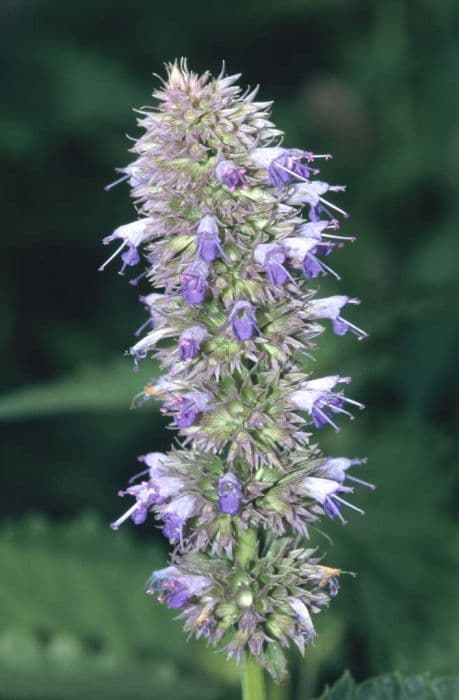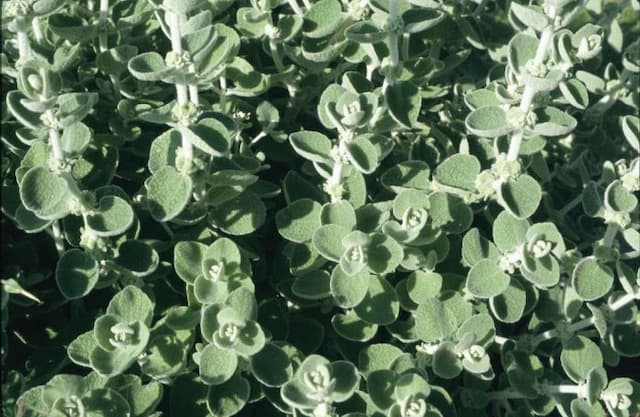Mexican Giant Hyssop Agastache mexicana 'Red Fortune' (PBR)

ABOUT
The Agastache mexicana 'Red Fortune', commonly known as Mexican Hyssop, is a vibrant and decorative perennial that is recognized for its striking appearance. This plant features a lush array of green foliage, which sets the stage for its most prominent feature – the vivid, tubular flowers that boast a brilliant red hue. The flowers are arranged in dense, spiky inflorescences that stand upright, giving the plant a poised and elegant aspect. The deep red blossoms of the Mexican Hyssop attract a range of pollinators, including bees, butterflies, and hummingbirds, adding a dynamic component to its display. The leaves of the Mexican Hyssop also contribute to its sensory appeal, emitting a pleasant, aromatic fragrance when brushed or crushed, which can add a layer of enjoyment to any garden setting. Throughout the growing season, the Mexican Hyssop continues to produce its red flowers, offering a long-lasting pop of color in the landscape. This combination of striking visuals and aromatic foliage makes the Mexican Hyssop 'Red Fortune' a popular choice for gardeners looking to incorporate a touch of drama and allure to their flowering borders, beds, or as part of a vibrant container display. Its resilience and relatively low maintenance needs further enhance its attractiveness to those wishing to add a resilient yet stunning plant to their outdoor spaces.
About this plant
 Names
NamesFamily
Lamiaceae
Synonyms
Mexican Hyssop, Red Fortune Hyssop
Common names
Agastache mexicana 'Red Fortune' (PBR).
 Toxicity
ToxicityTo humans
Mexican giant hyssop is not typically known for its toxicity to humans. However, as with any plant, individual allergies or sensitivities could potentially cause reactions in some people. If ingested in large quantities, there could be a potential for gastrointestinal discomfort or other symptoms, but generally, this plant is not considered toxic to humans. If you have specific health concerns or experience adverse effects after handling or ingesting Mexican giant hyssop, seek medical advice.
To pets
Mexican giant hyssop is not commonly known to be toxic to pets either. However, like in humans, individual animals can have allergies or reactions to plants that are generally considered non-toxic. Signs of an adverse reaction could include gastrointestinal upset, such as vomiting or diarrhea, if ingested. If your pet consumes Mexican giant hyssop and you notice any unusual behavior or symptoms, it is advisable to consult with a veterinarian.
 Characteristics
CharacteristicsLife cycle
Perennials
Foliage type
Deciduous
Color of leaves
Green
Flower color
Red
Height
2-3 feet (0.6-0.9 meters)
Spread
1-2 feet (0.3-0.6 meters)
Plant type
Herb
Hardiness zones
7
Native area
Mexico
Benefits
 General Benefits
General Benefits- Attracts Pollinators: The Agastache mexicana 'Red Fortune', also known as Mexican Hyssop, is known for attracting bees, butterflies, and other beneficial insects, which are essential for the pollination of many plants.
- Drought Tolerance: Mexican Hyssop has a natural resistance to drought, making it a great choice for xeriscaping or in gardens where water conservation is a priority.
- Easy to Grow: The plant is relatively low-maintenance, which is ideal for both novice and experienced gardeners.
- Long Blooming: It has a long flowering period, providing vibrant color in the garden for an extended season.
- Aromatic Foliage: The leaves of the Mexican Hyssop emit a pleasant fragrance, which can add a sensory appeal to your garden or outdoor space.
- Culinary Uses: The leaves and flowers of the plant are edible and can be used to flavor drinks and dishes.
- Landscape Uses: Due to its attractive flowers and foliage, Mexican Hyssop is often used in borders, container gardens, and as a specimen plant.
- Deer Resistant: It's less palatable to deer, making it a suitable choice for gardens in areas where deer are a common problem.
 Medical Properties
Medical Properties- Anxiolytic effects: Agastache mexicana, commonly known as Mexican Giant Hyssop, is sometimes reported to have anxiolytic properties, potentially helping to reduce anxiety.
- Antioxidant properties: The plant may contain compounds that exhibit antioxidant activity, potentially protecting cells from oxidative damage.
- Anti-inflammatory effects: Agastache mexicana might have components that can help in reducing inflammation within the body.
- Gastrointestinal relief: There are indications that the plant could be used to alleviate various digestive issues, including indigestion and gas.
 Air-purifying Qualities
Air-purifying QualitiesThis plant is not specifically known for air purifying qualities.
 Other Uses
Other Uses- Culinary Infusion: The leaves of Agastache can be used to infuse oils and vinegars with a unique flavor, giving a twist to salad dressings and marinades.
- Natural Dye: The flowers of the Agastache can yield tints and dyes for fabrics or art projects, offering a spectrum of reds and pinks.
- Floral Arrangements: Fresh or dried, the vibrant flowers provide visual interest in bouquets and decorative displays within homes and at events.
- Garden Companion Planting: Agastache can be used in the garden to attract pollinators, benefiting the growth of vegetables and fruit plants nearby.
- Educational Tool: The plant's attraction to pollinators makes it a useful specimen for educational purposes, showcasing plant-pollinator interactions.
- Herbal Sachets: Dried Agastache flowers and leaves can be packed into sachets to give a pleasant aroma to closets and drawers.
- Artistic Inspiration: The striking appearance of the 'Red Fortune' makes it a great subject for botanical illustration and photography.
- Homemade Potpourri: Combined with other dried flowers and spices, it can contribute to a homemade potpourri mixture.
- Livestock Forage: Though not a common use, Agastache can serve as forage for certain types of livestock, such as goats, under controlled conditions.
- Perfumery: The essential oils from Agastache flowers can be used in the making of natural perfumes, adding a delicate scent profile.
Interesting Facts
 Feng Shui
Feng ShuiThe Mexican Giant Hyssop is not used in Feng Shui practice.
 Zodiac Sign Compitability
Zodiac Sign CompitabilityThe Mexican Giant Hyssop is not used in astrology practice.
 Plant Symbolism
Plant Symbolism- Healing - Often associated with therapeutic properties and used in traditional medicine.
- Attraction of Pollinators - Represents the allure of nature and the importance of ecological balance, as it is a favorite among bees and butterflies.
- Warmth and Protection - Its vibrant red color can be seen as a symbol of warmth and vitality, offering a sense of comfort and shelter.
- Gratitude and Appreciation - The plant's generous blooming can signify thankfulness and acknowledging the richness of life.
- Love and Affection - Red flowers often denote deep love and passion, making this plant a symbol of strong emotional connections.
 Water
WaterMexican Hyssop should be watered deeply but infrequently, allowing the soil to dry out slightly between waterings. In general, during the growing season, it may need about 1 inch of water per week, which is roughly equivalent to 0.6 gallons for a medium-sized plant. Water at the base of the plant to avoid wetting the foliage, which can promote disease. During hot, dry spells, water may be required twice a week, while in cooler, overcast conditions, watering once every seven to ten days might suffice.
 Light
LightMexican Hyssop thrives in full sun to part shade. The ideal spot for this plant is a location where it receives at least 6 hours of direct sunlight each day. Avoid heavy shade areas, as this can lead to sparse flowering and a leggy growth habit. Dappled afternoon light is acceptable, especially in climates with extremely hot summers.
 Temperature
TemperatureMexican Hyssop prefers a temperature range of 50 to 90 degrees Fahrenheit. It can survive minimum temperatures down to about 20 degrees Fahrenheit but is not frost-tolerant. The ideal conditions for this plant are warm days with some nighttime cooling, as long as the temperature does not drop below the freezing point.
 Pruning
PruningMexican Hyssop should be pruned to promote bushier growth and to remove any dead or faded flowers, which encourages continued blooming. The best time for pruning is in the late winter or early spring, just before new growth starts. Prune back about one-third of the plant's size for optimal results. Regular deadheading of spent flower spikes during the growing season can also be beneficial.
 Cleaning
CleaningAs needed
 Soil
SoilMexican Hyssop thrives in well-drained soil with a pH ranging from 6.0 to 8.0. A mix of two parts garden soil, one part sand, and one part compost or well-rotted manure will support healthy growth, ensuring proper drainage while retaining adequate moisture and nutrients.
 Repotting
RepottingMexican Hyssop should be repotted every 2-3 years or when it outgrows its current container. This will ensure the plant has enough room to grow and fresh soil to extract nutrients from.
 Humidity & Misting
Humidity & MistingMexican Hyssop prefers moderate to high humidity levels but is quite adaptable and can tolerate lower humidity conditions typical of most home environments.
 Suitable locations
Suitable locationsIndoor
Place in bright light, ensure proper drainage.
Outdoor
Full sun, well-drained soil, protect from frost.
Hardiness zone
7-10 USDA
 Life cycle
Life cycleAgastache mexicana 'Red Fortune' (PBR), commonly known as Mexican Hyssop 'Red Fortune', begins its life cycle as a seed, requiring a period of stratification or a warm, moist environment to germinate. After sprouting, the seedling stage involves the formation of primary leaves which then grow into a juvenile plant, developing a root system and true leaves adapted for photosynthesis. As it matures into the vegetative stage, the plant grows in size and mass, producing a strong stem and additional foliage, preparing for the flowering stage. During the reproductive stage, 'Red Fortune' produces vivid red flowers that attract pollinators, which are essential for cross-pollination and seed production. Following pollination and fertilization, seeds develop which then disperse from the parent plant, completing the cycle. In colder climates, 'Red Fortune' may act as an annual, dying back after seed production, but in milder zones, it can survive as a perennial, going dormant in winter and re-emerging in spring.
 Propogation
PropogationPropogation time
Spring-early summer
Propogation: Agastache mexicana 'Red Fortune', commonly known as Mexican Hyssop, is usually propagated by seed. The most popular method involves sowing seeds indoors in trays or pots during late winter or early spring. Ideally, this would be about 6 to 8 weeks before the last frost date. The seeds should be spread on the surface of a well-draining seed starting mix and lightly pressed into the soil, but not covered as they need light to germinate. The soil should be kept moist, but not waterlogged, at a temperature of 65-70°F (18-21°C). Germination can take anywhere from 7 to 30 days. Once seedlings have grown sufficiently and there is no more risk of frost, they can be hardened off and transplanted outdoors to their final growing positions, ensuring they are placed in full sun and in well-draining soil.









